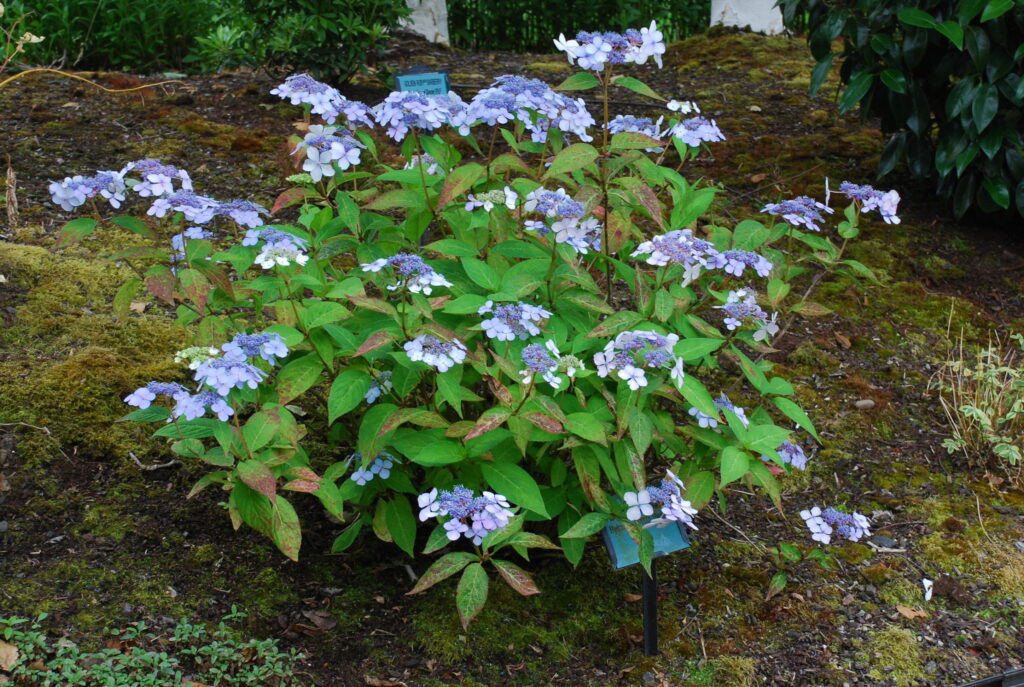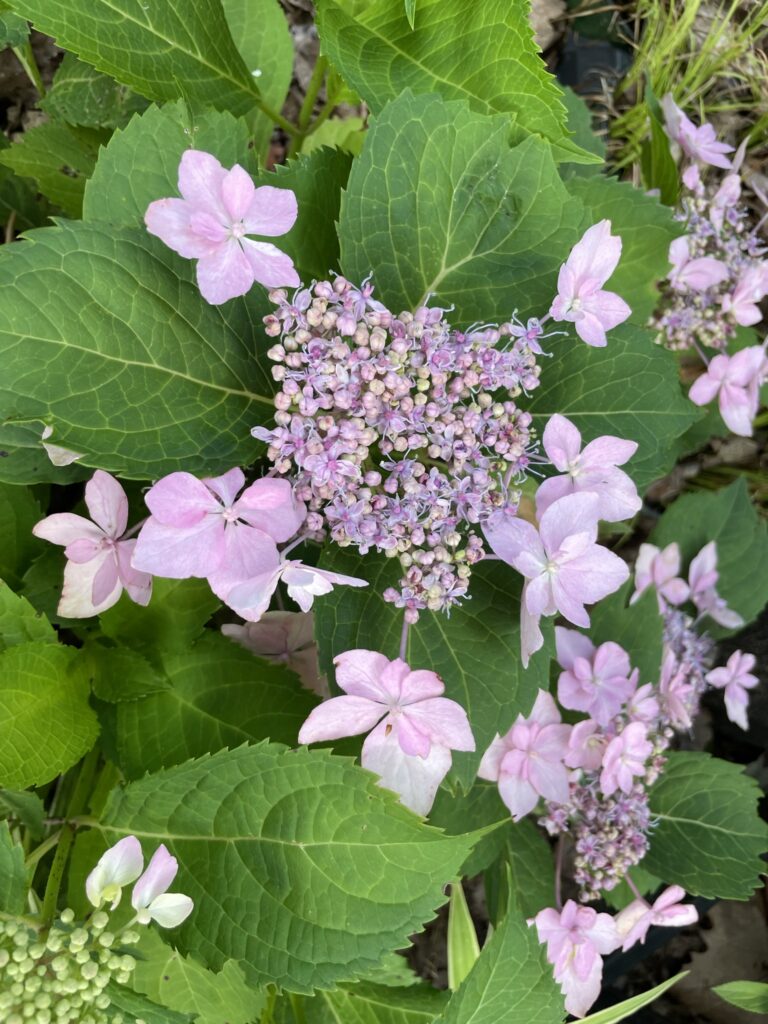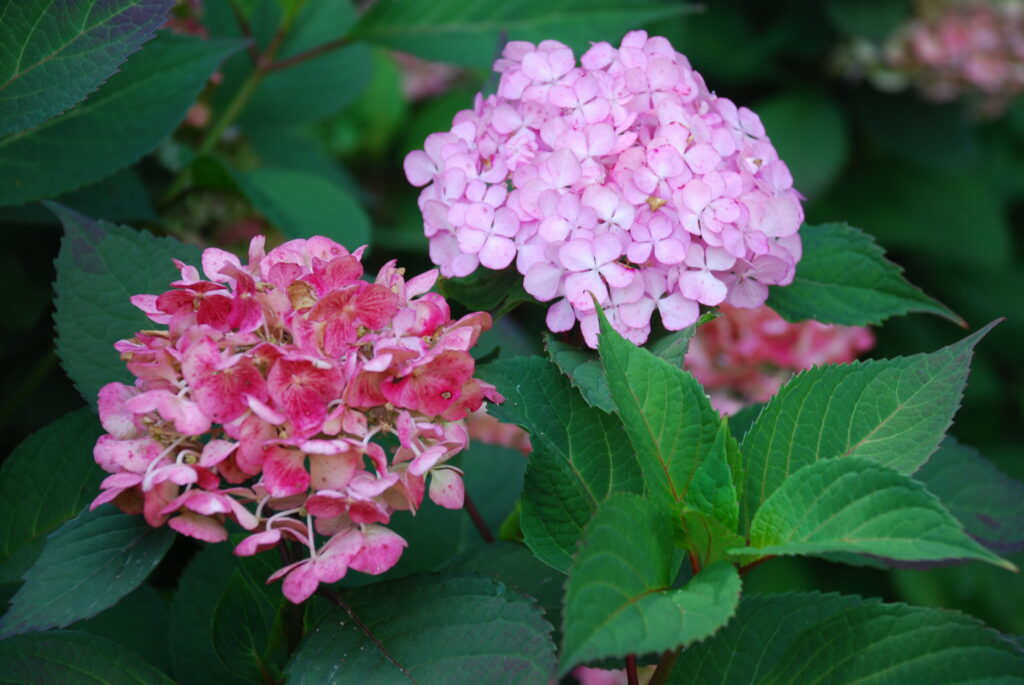
Mountain hydrangeas (Hydrangea serrata) look very much like big leaf hydrangea (H. macrophylla) except shrubs are smaller, more compact in growth habit with smaller flowers and leaves. They are native to the cool moist woodland valleys in Japan and Korea mountains. (USDA hardiness zones 6-9). These unique hydrangeas fare better in cool climates in zones 5 (protected) and 6 than bigleaf hydrangeas (H. macrophylla).
Current cultivars are listed below. Currently, Tuff Stuff™ series from Proven Winners (PW) is available through local garden centers. Currently, five cultivars have been introduced and are ideal compact hydrangeas for a small garden. Plant breeders are also crossing Mountain hydrangeas with other species.
Mountain hydrangeas begin blooming in early summer on old wood and continue to produce lacecap flowers on new wood from late June into October for a long bloom display. Utilize them as foundation planting, low hedging, front bed edging, or as a single specimen.
Leaves are toothed, ovate, dull green, up to 6 inches long) and their summer lacecap flowers are long-blooming. Most of the florets are fertile and attract pollinators. Smaller numbers of showy sterile florets form along an outer marginal ring around the tiny fertile florets. Mountain hydrangeas bloom on both old and new wood.
In alkaline soils (above 6.5 pH) pink florets are likely and blue florets in acidic soils. To achieve bluer blooms, lower the soil pH for 5.5 or lower feeding an acidic type fertilizer like Miracid™ or Hollytone™ or one specifically labeled for hydrangeas, one containing aluminum sulfate. Mulch beds with pine needles.

Tuff Stuff® hydrangea
Mountain hydrangeas should be grown in partial shade or in and out all day filtered sun. The soil should be humus-rich, moist and well-drained. Plants will handle more sun if soils are adequately irrigated. Little pruning is necessary if properly sited. Deadhead old spent flowers and prune out weak or winter-damaged stems in early spring.
Diseases are rare with some susceptibility to bud blight, bacterial wilt, leaf spot and mildew. Aphids are occasional visitors. Because of its compact mounding habit, annual pruning of Tuff Stuff™ hydrangeas is minimal other than to remove some broken branches.
Tuff Stuff® is a small reblooming hydrangea that bears pink lacecap flowers with creamy centers in alkaline soil; they are lavender-blue in acidic soil. Its serrated leaves turn burgundy in fall. At maturity Tuff Stuff often reaches 3×3 feet tall and wide.
Tuff Stuff Aha® grows 2-3 feet tall and wide. Tuff Stuff Ah-Ha® hydrangea will bloom pink or blue, depending on soil chemistry. Flower buds are more cold-tolerant, which ensures good blooming even in USDA zones 5 and 6.
Tiny Tuff Stuff® bears similar flowers to ‘Tuff Stuff’ but grows more compact shrub @ 2 feet high and wide.
Tuff Stuff Red™ is the newest addition to the Tuff Stuff series. Large, lacecap flowers are a deep pink-red color which is set off by lustrous, deep green foliage.
Tuff Stuff™ Red Mountain has improved bud hardiness and is a reliable rebloomer. This dwarf hydrangea grows 24 – 36 inches high and wide with blue or red lacecap flowers.

Other varieties with a H. serrata bloodline include: ’Blue Bird’, ‘Blue Billow’, ‘Pink Dynamo‘, ‘Diadem’, and ‘Preziosa’.

 Posted in
Posted in 
